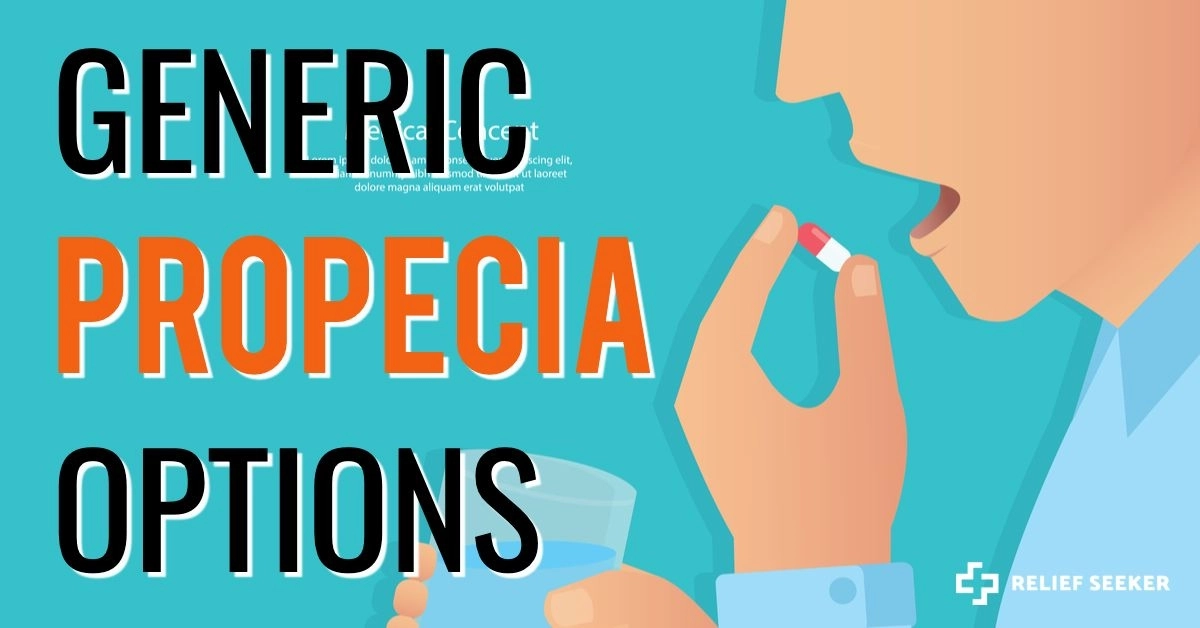Propecia is a brand-name prescription medication, used to treat male pattern baldness, hair thinning, and hair loss.
Is there a generic for Propecia? Yes! There’s absolutely a generic-brand alternative for this pricey brand-name medication. Since Propeica’s patent ran out, generic Propecia has also been made available and goes by the name finasteride.
Find out how to buy generic Propecia, where to get it, and how to save money on finasteride tablets for hair loss treatment.
What Is Propecia?
Propecia (also known as Merck Propecia under the brand name) is a hair loss treatment for male pattern baldness.
Originally introduced to the market as a treatment for benign prostatic hyperplasia (BPH), or an enlarged prostate, Propecia was approved by the Food and Drug Administration (FDA) as the prescription drug Proscar.
In the late 1990s, Propecia, a low dose of Proscar, was approved by the FDA to treat male balding and receding hairlines.
The active ingredient in Propecia is finasteride (which is also the name of the generic version of the drug) was able to slow hair loss and even promote some level of hair growth in a two-year trial.
Causes of Male Pattern Baldness
Male pattern baldness (also called androgenic alopecia) is generally caused by an influx of a sex hormone called Dihydrotestosterone (DHT), which is made from testosterone.
DHT is an important hormone that can help encourage body hair follicle growth (especially in the pubic region), but it can also cause hair on the head to stop growing, too. Why DHT causes body hair to grow in abundance but head hair to thin or stop growing is unknown. Yet, 50% of all men suffer from androgenic alopecia.
In women, DHT is created by a steroid chemical called dehydroepiandrosterone (DHEA), which is produced in the adrenal glands.
Medications developed to slow or stop male pattern hair loss target DHT, block this chemical, and are often called DHT blockers. While these medications cannot regrow hair, they can prevent future hair loss.
Preventing Male Pattern Baldness
Male pattern baldness is hereditary, meaning you’re more likely to develop this condition if the men in your family (especially your biologically close relatives) also suffer from alopecia. If your father, brother, uncle, or cousins suffer from this condition, you may want to consider some preventative measures.
Medications for male pattern baldness aren’t intended to regrow hair, meaning you’ll want to ensure you retain as much of your natural hair as possible. The best way to do this? Start using DHT blockers before you lose your natural hair.
The most common DHT blockers are brand-name Propecia and generic for Propecia medications, such as finasteride and minoxidil.
Propecia Vs Finasteride
Is there a generic for Propecia? Yes! There are two generic medications approved by the FDA to treat male pattern baldness, including finasteride and minoxidil.
Propecia started selling a 1mg dose of finasteride back in the late-90s specifically to treat male pattern baldness. In the past few years, the patent ran out on Propecia, and companies were given the green light to start producing and selling generic finasteride to treat alopecia. Finasteride works in the same way as 1 mg Propecia (in fact, Finasteride is the same as Propecia).
Benefits of Propecia
Propecia has been around since the 1970s. Originally developed to treat prostate enlargement, this drug has been deemed safe by the FDA for decades. Yet, Propecia also has shown to stop or slow the loss of hair in men by blocking DHT hormones, too.
The main benefits of Propecia include:
Effectively stops or slows hair loss in 80% of men suffering from alopecia
Has been shown to help regrow hair in up to 64% of users
Used by men for nearly 50 years
Comes with the brand-name recognition of Merck
Most men (about 85%) don’t experience side effects when taking Propecia
Benefits of Finasteride
Finasteride is the generic name for Propecia. This generic drug hit the market a few years ago when Propecia’s patent ran out.
Though it’s sold under the name finasteride, this generic medication is essentially the same medication sold for decades under Propecia through the Merck family of prescription medications.
The main benefits of finasteride include:
Effectively stops or slows hair loss in 80% of men suffering from alopecia
Has been shown to help regrow hair in up to 64% of users
Most men (about 85%) don’t experience side effects when taking finasteride
Much more cost-effective than its brand-name counterpart
Propecia Vs Finasteride: The Bottom Line
If you’re trying to decide which medication to use for male pattern baldness, you may have a bit of a tough choice: there’s very little difference between generic finasteride and the brand-name Propecia. In fact, the name is the main difference.
If you have health insurance, your doctor may simply prescribe you Propecia; simply pay an insurance co-pay to get your medication. If you don’t have health insurance, you may want to opt for the generic medication finasteride, as generic medications usually cost a fraction of what their brand-name counterparts do.
Minoxidil Vs Finasteride
Another generic medication used to treat male pattern baldness is minoxidil. This medication is most commonly used to treat high blood pressure. The brand-name version of this generic medication is Rogaine.
Like Propecia, Rogaine has been around for several decades. It first hit the market in 1986 as a treatment for male pattern baldness. The benefit that minoxidil has over finasteride is that it can actually help grow hair back and promotes hair regrowth. Yet, this medication isn’t without its downsides, too.
Benefits of Minoxidil
Minoxidil has one benefit over its competitors: it helps to regrow hair — not just slow down or stop hair loss. Yet, this medication has been around for quite a long time, which means it has been thoroughly tested and comes with brand recognition.
The main benefits of minoxidil include:
Helps to regrow hair — not just slow hair loss
Has been sold since the 1980s
Created to be used topically
Benefits of Finasteride
The biggest difference between finasteride and minoxidil is that finasteride is generally used to stop or slow hair loss, while minoxidil is used to regrow hair. While most men may assume that minoxidil is the better choice (who wouldn’t want their original lush head of hair?), it comes with a few other downsides, too.
Minoxidil has a few side effects that make it slightly less appealing than finasteride, including acne, burning scalp, facial hair growth (for women), inflammation, swelling, and further hair loss.
Though, some studies do show that very few people experience side effects and that the drug shows no systemic side effects.
The main benefits of finasteride over minoxidil include:
Reduces hair loss and may even stop hair loss altogether
No itching, burning, or swelling
Can be taken orally
Minoxidil Vs Finasteride: The Bottom Line
When it comes to minoxidil versus finasteride, what you take depends on your needs. One stops hair loss and receding hairlines and promotes some level of regrowth while the other simply promotes hair growth.
If you’re losing hair, you will want to take finasteride to decrease your chances of further hair loss (and even stop hair loss altogether). If you want to grow new hair follicles you’ll want to take minoxidil.
Studies show that it’s safe to take both finasteride and minoxidil at the same time; you may want to talk to your doctor or a doctor at a digital clinic before starting these medications to ensure they’re safe for you to take simultaneously.
Is There a Generic for Propecia?: Cost of Generic Vs Brand-Name
One of the biggest reasons to start taking generic Propecia is that generic versions of brand-name medications are almost always more cost-effective.
Generic Propecia (finasteride) starts at about $8 for 30 tablets; brand-name Propecia starts at about $110 for the same amount.
If you have health insurance, your healthcare provider may be able to prescribe you brand-name Propecia, and you’ll only pay a small co-pay (which may cost less than the bottle of brand-name product). If you don’t have health insurance, you may want to opt for the generic version of this medication.
Most digital clinics offer deals for setting up a medication subscription. Companies like Roman offer the first two months of finasteride for free (and $20 a month for a three-month supply thereafter).
Common Side Effects of Finasteride Vs Propecia
Finasteride and Propecia are the same medication, which means the side effects for each will be the same (unless side effects are caused by an irregularity in the production process). Before starting finasteride or brand-name Propecia, it’s important to tell your doctor about any medications you’re currently taking to avoid drug interactions.
In a 2016 study, a small percentage of finasteride users experienced some side effects. About 2% of users reported issues with libido and 1.4% of users experienced ejaculation issues. In a four-year trial about 6% of finasteride users experienced decreased libido.
According to the Indian Dermatol Online Journal:
“Two studies in 1998 and 1999 showed that the incidence of these side effects with finasteride therapy was generally comparable to that observed with the treatment with placebo,[8,9] and there was no evidence of dose-dependency or increased incidence with longer therapy out to 12 months. In addition, the side effects ceased in patients even when they continued to receive finasteride.”
In longer studies, the side effects of finasteride users were comparable to those taking the placebo.
The most common side effects of finasteride include:
Decreased sex drive
Swelling in hands and feet
OTC Propecia
If you’re looking for over-the-counter Propecia or finasteride, you won’t find it. You’ll need a doctor’s prescription to get both the brand-name Propecia as well as the generic version in the U.S.
The good news is that there are plenty of inexpensive ways to purchase finasteride (even if you don’t have health insurance).
If you have a healthcare provider, you may be able to get a prescription for generic finasteride (and only pay the cost of a doctor’s visit or consultation). If you don’t have a primary healthcare provider, you can always buy generic Propecia from a digital clinic (saving you the cost of the doctor’s visit or substantially lowering such costs).
Where to Buy Generic for Propecia
If you’re wondering, Is there a generic for Propecia? Look no further. Generic Propecia finasteride tablets are available both through your healthcare provider and via telehealth providers.
Both are ideal ways to save money on generic prescriptions and get the same high-quality meds at a fraction of the price.
Doctor’s Office
One of the most common ways to get finasteride is through your doctor. Simply make an in-person appointment, get your prescription, and fill it at your local pharmacy.
Digital Clinic
One of the most convenient ways to get diagnosed and treated for a long list of ailments is through a digital clinic. These clinics hire doctors, doctor’s assistants, and nurse practitioners — all of who can prescribe medication for hair loss.
The best part about digital clinics is that you don’t need to head to a local doctor’s office to get treated. Simply fill out a health questionnaire online, get a virtual consultation (usually by email), and get your treatment mailed directly to your home or office from the clinic or a compound pharmacy.
Most digital clinics don’t charge for doctor consultations — as long as you order medication directly from the clinic. Some clinics charge a small fee for consultations (usually the fee costs less than a copay).
Two of the most popular digital clinics that currently prescribe generic Propecia include Keeps and Roman.
Keeps
Keeps is a digital clinic, specializing in hair loss treatments. Order both finasteride and minoxidil, and get both shipped to your home or office. Finasteride costs approximately $25 a month, and minoxidil costs about $10 per month, making it affordable to regrow hair and slow down or stop future hair loss.
Roman
Roman is a digital clinic that specializes in a wide variety of men’s health concerns, including hair loss, erectile dysfunction, and skin issues. Currently, Roman sells minoxidil for $16 a month (with the first month’s supply free of charge). Finasteride starts at $20 a month for a three-month subscription (with the first two months’ supply free of charge).
Both digital clinics offer free shipping.
Is there a generic for Propecia? Yes! Not only is there a generic form of Propecia, but it’s safe, has a low chance of side effects, and is more cost-effective than its brand-name counterpart.


